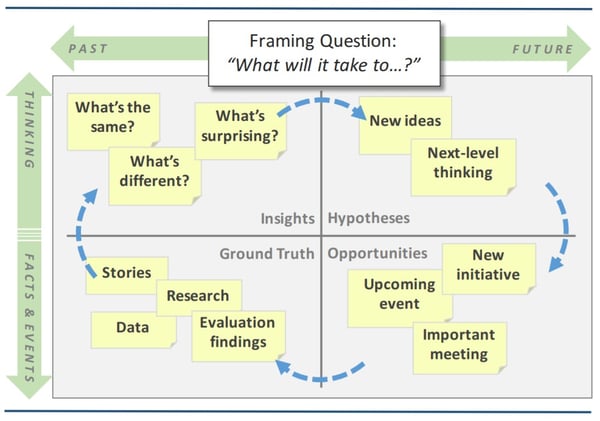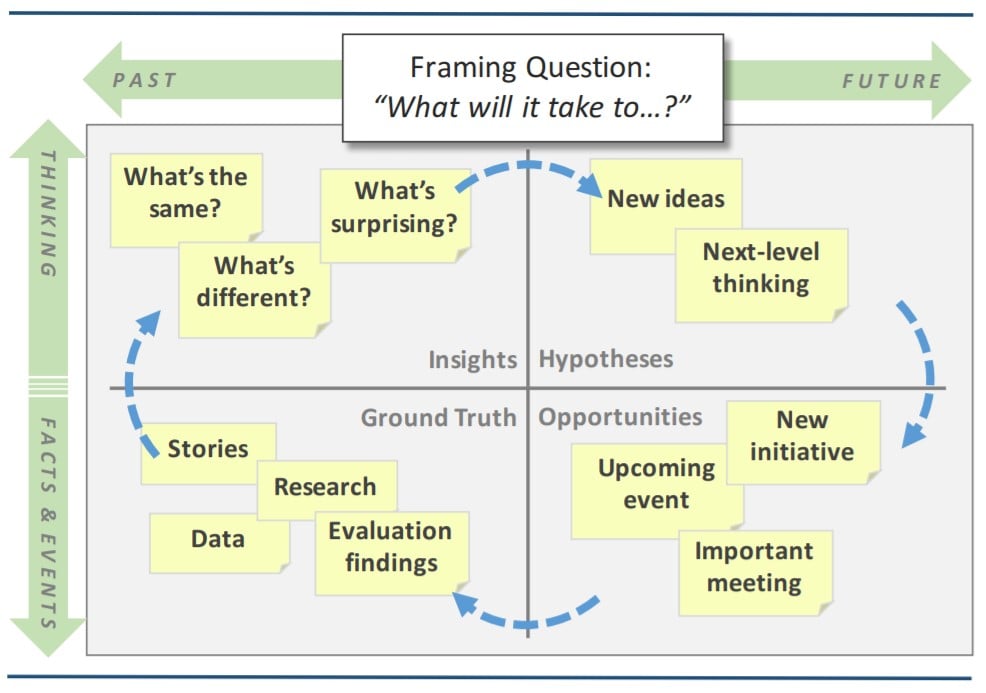Emergent Learning Frameworks
“Emergence is a process by which, through many interactions, individual entities or “agents” create patterns that are more sophisticated than what could have been created by an individual entity. And, as a corollary, no one entity (e.g., funder, grantee, or expert) could have envisioned the entire solution a priori. (Holland, 1995)”[i]
Communication and collaboration amongst teams, organizations, and stakeholder groups is at the core of emergent learning. Emergent learning relies upon conversations of success - and failure – to test hypotheses and to understand the context of implementation and outcomes. Three major benefits of working collaboratively are, “1) it generates more robust solutions that take into account a range of situations; 2) it creates more ownership for the solution rather than imposing it; and 3) it sets the stage for learning and adaptation at every level of implementation. (Marilyn Darling and Charles Parry, 2007)”.[ii]
Frameworks established to support emergent learning are straightforward and simple. The idea of the framework is to facilitate emergent learning, not to distract from it with overcomplicated tools.
1. Before Action Review (BAR) and After Action Review (AAR): During the BAR, groups work to clarify objectives, identify potential challenges, and develop hypotheses. The BAR tests hypotheses against results and seeks to provide context from multiple perspectives for more robust understanding. Figure 3 from the Emergent Learning: A Framework for Whole-System Strategy, Learning, and Adaptation article illustrates the questions asked during each review. Note, the overlap and circularity between the BAR and AAR. This is not a static framework. That is the point.
 2. Emergent Learning Tables: Emergent Learning Tables provide structure to the group’s conversations to encourage clear thinking about the problem before jumping to problem solving. Bringing together more information, data, and varied perspectives can accelerate the learning. A group benefits from the experience and best thinking of all involved. Figure 4 from the Emergent Learning: A Framework for Whole-System Strategy, Learning, and Adaptation article shows this structure.
2. Emergent Learning Tables: Emergent Learning Tables provide structure to the group’s conversations to encourage clear thinking about the problem before jumping to problem solving. Bringing together more information, data, and varied perspectives can accelerate the learning. A group benefits from the experience and best thinking of all involved. Figure 4 from the Emergent Learning: A Framework for Whole-System Strategy, Learning, and Adaptation article shows this structure.

3.Learning Logs: Learning logs bring these two tools together. They document key events and insights developed through the BAR, AAR, and Emergent Learning Tables.
Simple tools for complex problems. Emergent learning for deeper understanding. As we grapple with how best to address the accelerating effects of climate change within a global complex context, can these tools help move along the conversations to develop and implement effective solutions?
In the Next Issue
Stay tuned for a surprise topic.
[i] Darling, Marilyn J., Sparkes Guber H., Smith J. A., Stiles J. E. M.. Emergent Learning: A Framework for Whole-System Strategy, Learning, and Adaptation, 2016. https://scholarworks.gvsu.edu/cgi/viewcontent.cgi?referer=&httpsredir=1&article=1284&context=tfr
[ii] Darling, Marilyn and Parry, Charles. Growing Knowledge Together: Using Emergent Learning and EL Maps for Better Results. Reflections - The SoL Journal on Knowledge, Learning and Change, volume 8, 2007.
About This Blog
We are on the brink of an evaluation renaissance. Smart grids, smart meters, smart buildings, and smart data are prominent themes in the industry lexicon. Smarter evaluation and research must follow. To explore this evaluation renaissance, I am looking both inside and outside the evaluation community in a search for fresh ideas, new methods, and novel twists on old methods. I am looking to others for their thoughts and experiences for advancing the evaluation and research practice.
So, please…stay tuned, engage, and always, always question. Let’s get smarter together.

